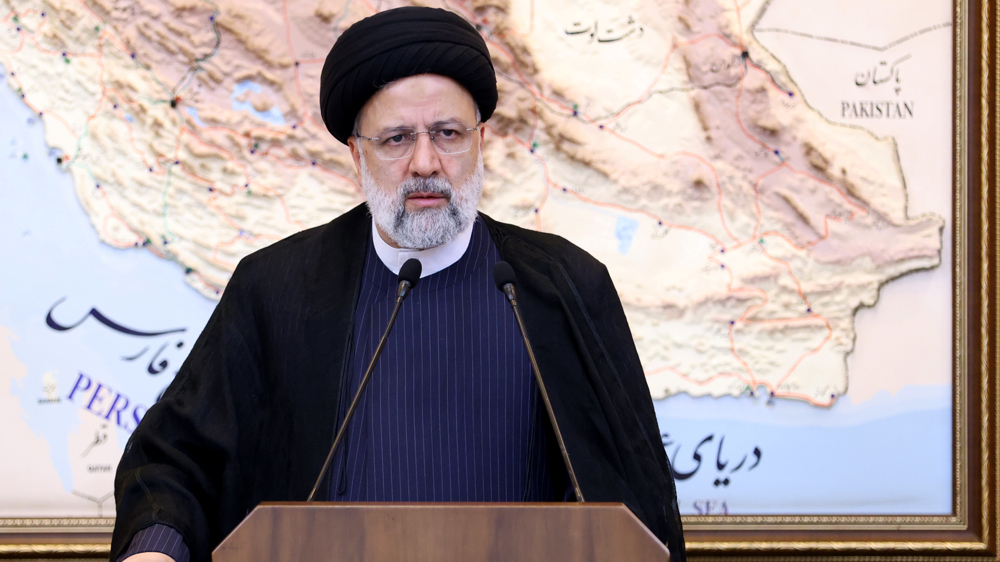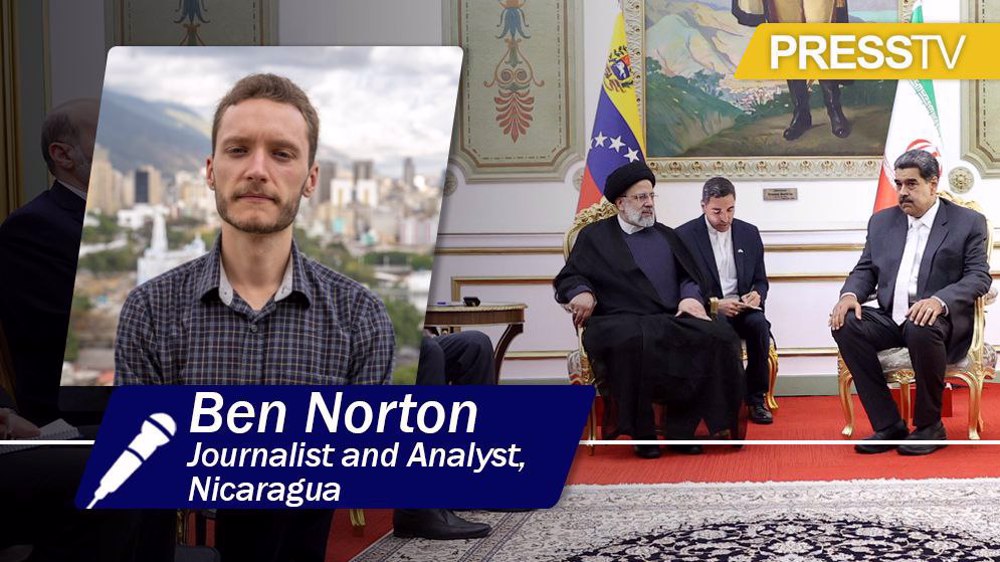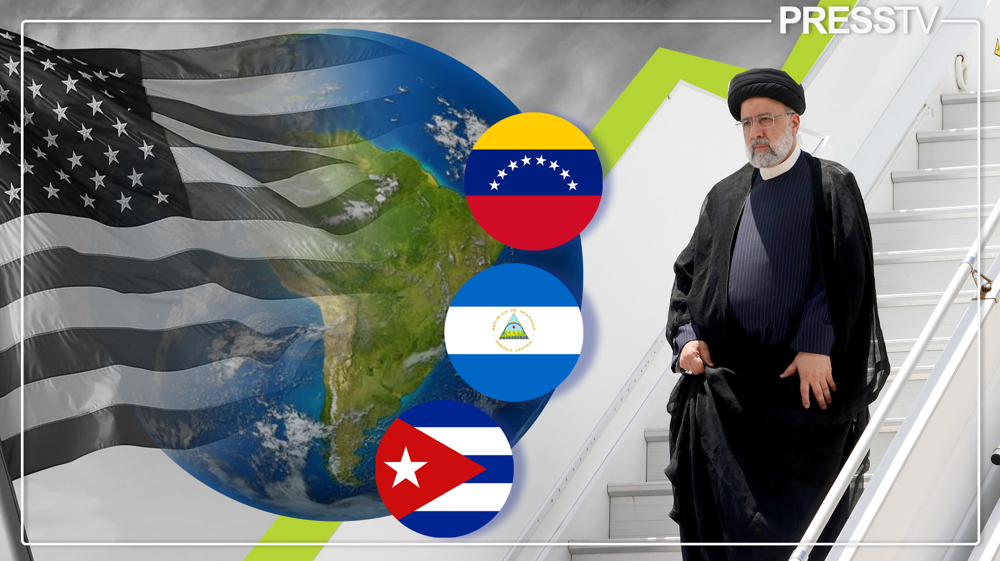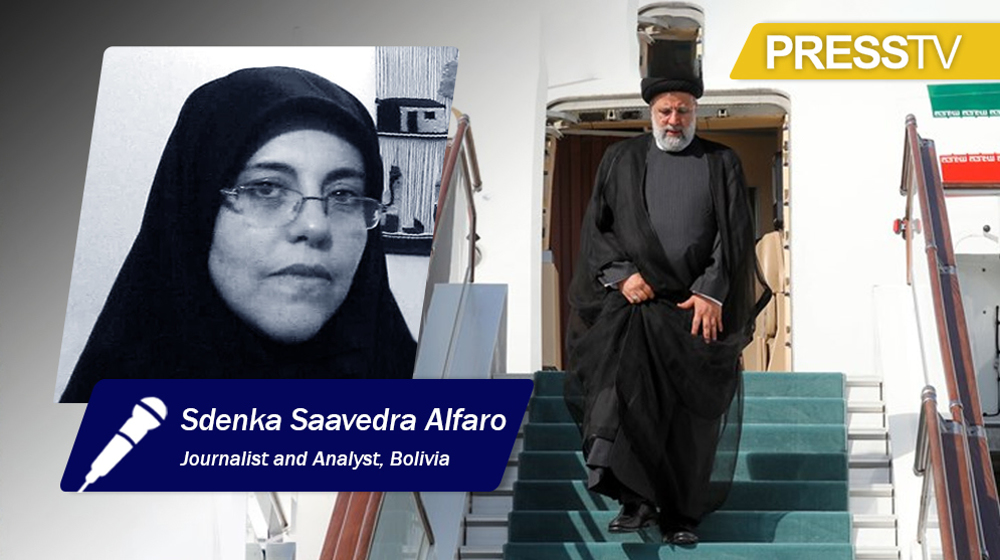A history of meddling: Why Iran, Latin America see common enemy in US
By Hamid Javadi
In President Ebrahim Raeisi's meetings with leaders of Venezuela, Nicaragua and Cuba during his recent three-nation tour of Latin America, the pressing issue that figured prominently in discussions was resistance against US interventionism across the world.
Latin America holds massive geopolitical significance in Iran’s foreign policy. The implications of President Raeisi’s trip extend beyond just bilateral relations. They signify a broader shift in the existing capitalist world order, with independent countries finally announcing their arrival on the big stage.
Iran’s call for a stronger resistance front against the United States -- stretching from West Asia to the Western Hemisphere -- resonates with millions of people in Latin America who aspire for independence and economic prosperity.
A quick review of history reveals why Latin American countries - Venezuela, Nicaragua and Cuba in particular - hold a grudge against the United States and are so enthusiastic about forging alliances with like-minded countries from the other corner of the world.
There is no nation in Latin America and the Caribbean that has not been at the receiving end of the unutterable horrors of US imperialism at one time or another.
American meddling has come in various shapes and forms -- from spying and military coups to proxy wars, from full-blown military invasions to annexation of territories -- dating back to the early 1800s.
Recap of US Interventions in Latin America
Here is a brief list of events that stand out in the long and bloody history of US meddling in that part of the world.
The US invaded Mexico in 1846 and annexed what is now known as the Western United States. It went on to invade Cuba, the Dominican Republic, the Caribbean Island of Grenada, Panama, and Haiti, and orchestrate coups in Guatemala, Brazil, Haiti, Venezuela, and Honduras.
Since President James Monroe issued a unilateral declaration in 1823, supposedly to counter European interference in the Americas, the US has involved itself in the daily affairs of the region, often to replace adversarial governments with friendly regimes to secure US commercial interests.
US policy in the Western Hemisphere was guided to a large degree by the Monroe Doctrine for almost a century until President Theodore Roosevelt expanded the doctrine in 1904 by introducing what came to be known as the “Roosevelt Corollary.”
The corollary granted the United States the authority to intervene in any Western Hemisphere country that it deemed necessary.
Since the introduction of the Monroe Doctrine, any military intervention in Latin America, and anywhere else in the world for that matter, has been framed as missions not to expand American power but to promote republican institutions and rescue the less fortunate people.
This paternalism was also heavily tinged with racism: American expansionism was justified on the grounds of white supremacy. American leaders essentially regarded Latin Americans as “colored” natives in need of guidance from superior whites.
Cuba
When President William McKinley sent American troops to Cuba in 1898 to fight against the Spanish colonial army, he said he was doing so to stop “oppression at our very doors.”
In many ways, 1898 was a watershed year for American imperialism on a global scale, and Cubans were the first to experience the impact of this profound transformation in the American psyche: The US was no longer content with the territory it held in North America.
The Spanish-American War of 1898 put an end to three centuries of Spanish rule, but it also put the United States in control of not only Cuba, but Hawaii, Puerto Rico, and the Philippines.
The Cubans, who had fought tenaciously for independence, initially cheered the American involvement. However, they would watch in frustration as the United States increasingly assumed the role of their new overlord.
In the years following the war, the US used everything in its imperialist toolbox, including the imposition of American-friendly dictators, to maintain control of Cuba.
It is no coincidence that when the Republic of Cuba was finally established on May 20, 1902, it found itself in the grip of periodic rebellions and assaults on American assets.
The US signed a treaty with Cuba in 1903 that gave it near-total control of Cuban affairs. The treaty allowed the US to establish a naval base at Guantanamo Bay, (which would become synonymous with CIA prisoner abuse and torture a century later).
A protest against electoral fraud in 1906 gave the US the pretext it was looking for. American forces landed in Cuba once again supposedly to quell the unrest. They assumed direct military control over the embattled nation.
When American soldiers left Cuba a few years later, President William Howard Taft warned that it was “absolutely out of the question that the island should continue to be independent.”
US interventions in the daily affairs of Latin American countries led to a surge of nationalism across the region in the 1920s and 1930s. Cuba was particularly swept by anti-American sentiments.
US President Franklin Roosevelt encouraged the Cuban army to revolt, paving the way for the rise of a sergeant named Fulgencio Batista.
Batista's ascent to power began in 1933 through an uprising known as the Revolt of the Sergeants, which ousted the interim government of Carlos Manuel de Céspedes y Quesada.
Batista appointed himself chief of the armed forces and effectively ruled Cuba by installing a series of puppet presidents until 1940 when he won the presidential election on a populist platform.
He invited American investors and gangsters to Cuba to lay the foundation of a lucrative tourism industry, mostly based on prostitution and casino gambling.
However, Batista is most notorious for his decision to cancel the congressional election of 1952.
Fidel Castro, a charismatic lawyer, was a candidate in that election. Castro turned to revolution when the US-backed military strongman’s coup blocked his path to electoral politics.
Batista fled Cuba on New Year's Day 1959. The following day, Castro descended from his mountain stronghold to Santiago to deliver his first speech as leader of the Cuban revolution.
“This time, fortunately for Cuba, the revolution will achieve its true objective. It will not be like 1898 when the Americans came and made themselves masters of the country,” he declared.
Americans would not sit idly by and watch the jewel in the crown of their Latin American imperialism slip through their hands.
In 1961, the CIA sponsored Cuban exiles to invade the island in a failed attempt to depose Castro. Successive US presidents vowed to bring him down while the CIA made several attempts on his life.
Castro survived and devoted his life to fighting American imperialism, etching his name in history as an icon of anti-Americanism. He became a hero to millions of freedom-loving people around the world.
The embargo the United States imposed on Cuba in 1960 following Castro’s hugely popular revolution not only remains in place but has been strengthened over the years.
Last year, the UN General Assembly strongly for the 30th time rebuked Washington for its crippling embargo on Cuba, with 185 countries voting in favor of a non-binding resolution slamming the embargo.
“If the US government was really interested in the welfare, human rights and self-determination of Cubans, it could lift the blockade,” said Yuri Gala, Cuba’s deputy representative at the UN.
Nicaragua
Cuba was not the only Latin American country where the wind of anti-American sentiments blew strongly. Elsewhere in the Americas, entire nations were standing up to US interventionism.
One such place was the Caribbean nation of Nicaragua.
The US used the same refrain it had invoked against Cuba in 1898 a decade later when the Taft administration declared that it was overthrowing the government of Nicaragua to impose “republican institutions” and promote “real patriotism.”
Thus began a century of tensions between the US and Nicaragua. The US overthrew President José Santos Zelaya in 1909. The coup drew the United States into decades of interventions in Nicaragua, as a result of which thousands of people were killed and generations of Nicaraguans suffered.
Zalaya was arguably one of the most formidable leaders Nicaragua has seen. His attempts to restrict and regulate American enterprises in the country and his decision to seek loans from European rather than American banks prompted the US to depose him.
Washington went on to install Adolfo Diaz, chief accountant for the American-owned La Luz Mining Company, as president of Nicaragua. Diaz returned the favor by allowing American advisers to effectively call the shots in his government.
Nicaraguans never accepted their country's role as a protectorate of the United States, which by 1912 was running key sectors of the country’s economy, including its central bank, railway and steamship line.
Díaz's ties to the US made him a loathed figure in Nicaragua, which was gripped by nationalistic fevers, especially within the ranks of the military.
The secretary of war, Luis Mena, accused President Díaz of “selling out the nation to New York bankers” and rebelled against his government. A force led by Gen. Benjamin Zeledon, a fervent admirer of Zelaya, came to his aide.
Díaz asked the United States for help, and that became a pretext for the US military occupation of Nicaragua, which lasted for over two decades.
Four years after American troops finally left Nicaragua in 1933, General Anastasio Somoza Garcia, the ambitious commander of the American-created National Guard, seized the presidency for himself.
He went on to become the patriarch of the Somoza family, which ruled Nicaragua as a family dictatorship for 42 years.
No sooner had Somoza been assassinated in 1956 than a group called the Sandinista National Liberation Front (FSLN) revolted against the Somoza dictatorship. The revolution succeeded in 1979 and the FSLN forged an anti-American alliance with Fidel Castro’s Cuba.
US President Ronald Reagan responded by launching another round of war in Nicaragua that dragged on for nine years, turning the Central American nation into a bloody battlefield of the Cold War.
The US occupation of Nicaragua in 1912 set a dangerous pattern that shaped US foreign policy throughout the twentieth century and well into this century.
In recent years, the successive US governments have tightened the sanctions regime against Nicaragua on various flimsy pretexts, targeting mainly the country’s mining industry.
After Daniel Ortega was sworn in as Nicaragua’s president for a fourth straight term in January last year, the US and EU tightened sanctions against the country.
Venezuela
The United States has been poking its nose into Venezuela’s internal affairs since the 19th century.
For most of the 20th century, the US meddling in Venezuela, which sits atop vast natural resources, was mostly about oil. But that has not been always the case.
The United States orchestrated its first coup in Venezuela in 1908 when US Marines helped Vice President Juan Vicente Gómez seize power.
Nicknamed “the Catfish,” Gómez would rule Venezuela either directly or indirectly by appointing puppet presidents, until his death in 1935.
Gómez ruled by an iron fist-- shackling, torturing, and murdering political prisoners in grillos. However, he endeared himself to the US by giving lucrative concessions to foreign oil companies such as Standard Oil (ExxonMobil today) and Royal Dutch Shell.
For the purpose of exploiting Venezuela’s abundant petroleum resources, the US extended the same policy of backing Gómez and ignoring his rights abuses to Marcos Pérez Jiménez, a military general who seized power in a coup in 1948.
Like Gómez, Jiménez was as generous to transnational corporations as he was brutal to Venezuelans.
Venezuela finally shifted to democracy in 1958, at a time when most other South American nations were seething under US-backed military dictatorships.
Venezuelans enjoyed decades of peace and prosperity, but Washington would have none of it.
After the free and fair election of Hugo Chávez in 1998 and his subsequent launch of the Bolivarian Revolution-- a series of economic and social reforms -- the US took its campaign of interventionism to unprecedented new highs.
The Bolivarian Revolution, which nationalized key sectors of the economy and greatly improved the standard of living for Venezuelans, made Chávez a national hero. It also made him a marked man in Washington.
The administration of US President George W. Bush backed a military coup against Chávez in 2002. The coup ultimately failed, and Chávez returned to power in less than 48 hours.
President Barack Obama continued to demonize Venezuela, branding the country as an “extraordinary threat to national security” of the US, even though Venezuela had never initiated a war in its history.
Obama’s successor, Donald Trump, imposed economic sanctions against the government of Nicolás Maduro, who was elected president following the death of Chávez in 2013.
He also threatened to attack Venezuela militarily to depose the democratically-elected Maduro.
In 2019, Trump recognized opposition figure Juan Guaidó as the legitimate president of Venezuela in an attempt to provoke subversion within the country’s government and military. Maduro said at the time that by pushing for Guaidó to take over, the US planned “to govern Venezuela from Washington.”
Encouraged by Washington, Guaidó launched a botched coup to oust Maduro.
Trump’s hawkish national security adviser John Bolton — a cheerleader for the 2003 invasion of Iraq and “regime change” in Iran and Venezuela, called Venezuela, Cuba and Nicaragua a “troika of tyranny.”
Only after Russia’s military campaign in Ukraine in February 2022 disrupted the global oil market, the United States floated a potential reboot of relations with the government of Maduro. Washington even allowed US oil giant Chevron to resume its operations in Venezuela.
However, this gesture of détente was never sincere. It fizzled when the US excluded Venezuela, alongside Cuba and Nicaragua, from the Summit of Americas it hosted in Los Angeles in June 2022.
For Venezuela, Cuba and Nicaragua, the exclusion was reminiscent of the long history of America’s heavy-handed meddling in the internal affairs of Latin American countries.
If history is any guide, the US has always tried to undermine — through invasions, coups, and sanctions — countries that chose to independently pursue their own political and economic interests.
After returning home from his tour of Latin America on Friday, President Raeisi praised nations of that region for decades of resistance against the US-led imperialist system and the current “unjust” world order.
This spirit of resistance, the president stressed, is also shared by the Islamic Republic of Iran.
Hamid Javadi is a senior Iranian journalist and commentator based in Tehran.
VIDEO | Israel's brutal treatment of disabled Palestinian detainees: The case of Ali Hanoun
Iran signs $2.5 billion deals with domestic firms to boost oil production
Iran displays naval power, slams threats during BRICS Plus drills
China reaffirms support for Iran, Saudi minister calls for diplomacy
VIDEO | Press TV's news headlines
Two-year old girl shot by foreign-backed rioters dies in northeast Iran
Iran calls out US, Israeli roles in Daesh-like violence of rioters
Washington finalizes $500 million Venezuelan oil sale after illegal military intervention















 This makes it easy to access the Press TV website
This makes it easy to access the Press TV website